16 Wall Plants for Stylish and Space-Saving Indoor Greenery
Plants that grow well on walls can add beauty and life to any space. They work in small areas and can improve air quality while making rooms or outdoor areas more inviting. Many people look for plants that are easy to care for and fit well in different lighting conditions.
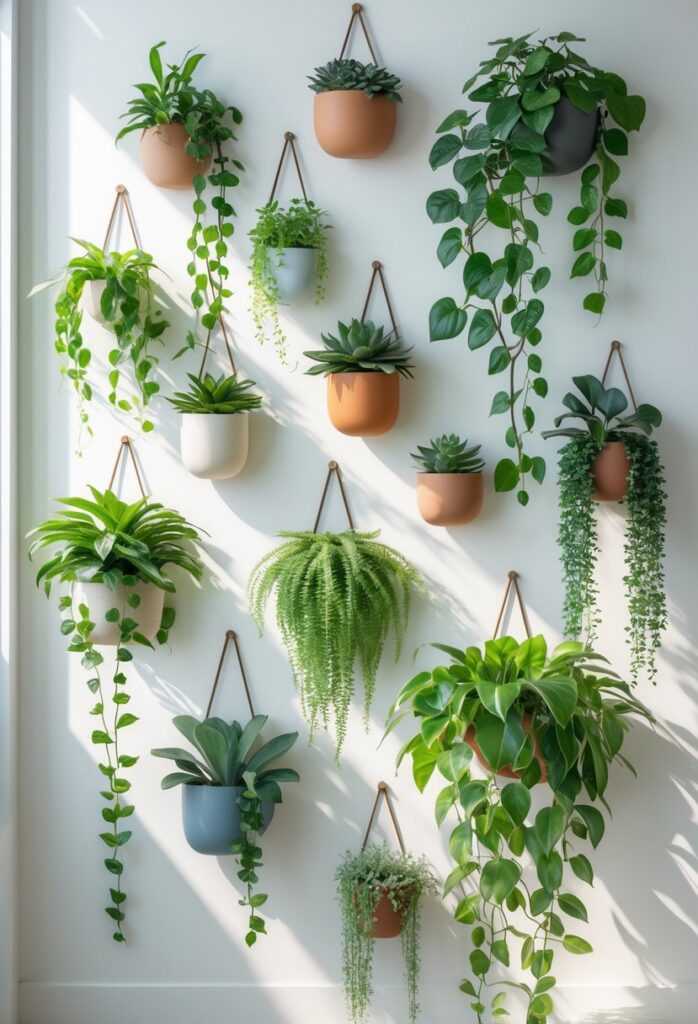
This article explains 16 different wall plants that suit a range of environments and styles. These plants can be used indoors or outdoors to create green walls or hanging gardens. Understanding these options helps people choose the best plants for their space and needs.
1) Snake Plant (Sansevieria)
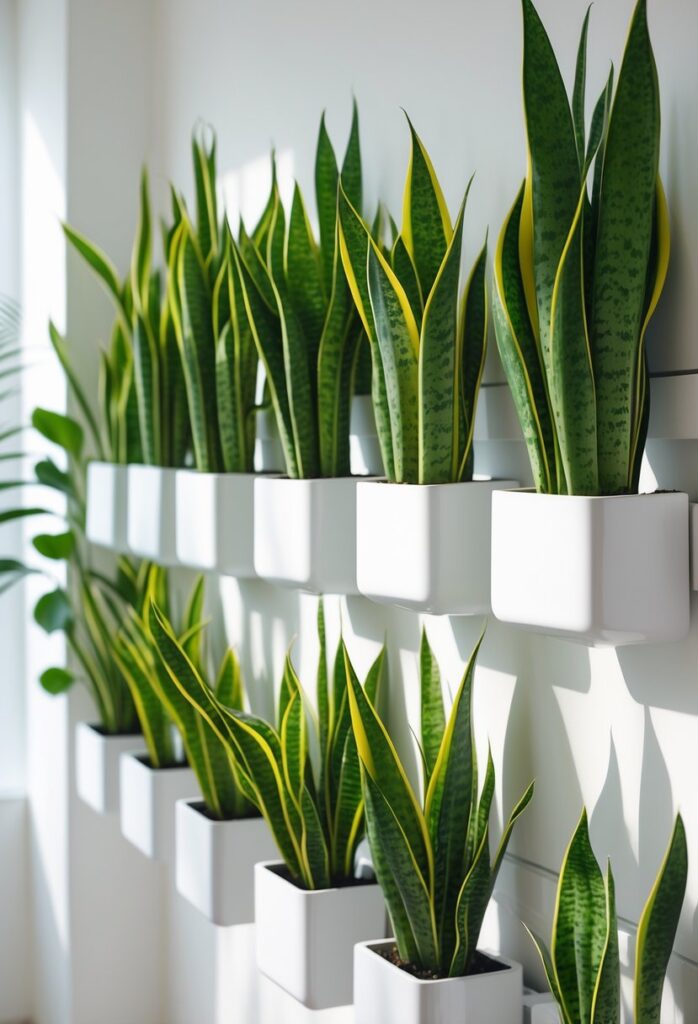
The Snake Plant, also known as Sansevieria, is a popular choice for wall planting. It has tall, upright leaves that add a modern look to any space. This plant is known for being very tough and low-maintenance.
It can grow well in low light, making it ideal for indoor walls. The Snake Plant does not need frequent watering and tolerates dry air. This makes it a good fit for people who may forget to water regularly.
Sansevieria is also a succulent, so it stores water in its leaves. It grows slowly but steadily and can live for many years indoors. Its shape and texture create visual interest on a vertical surface.
Due to its hardiness and easy care, the Snake Plant is a favorite for beginners. It can thrive in various conditions and still look healthy. More detailed care tips can be found in this Sansevieria care guide.
2) Pothos (Epipremnum aureum)
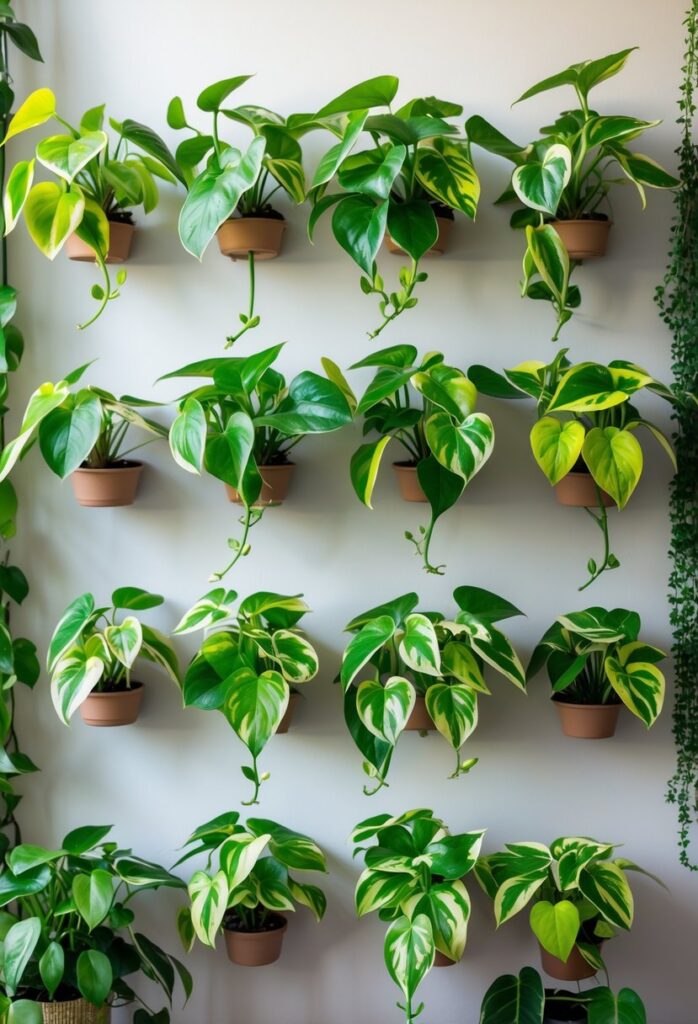
Pothos is a popular choice for wall plants because it grows quickly and adapts well to indoor conditions. It has heart-shaped leaves that come in different shades of green, often with yellow or white variegation.
This plant thrives in medium to bright indirect light but can also tolerate low light. It prefers temperatures between 18 and 29 degrees Celsius and humidity around 50-55%. The soil should be rich, well-drained, and kept moderately moist.
Pothos can climb walls easily by using its aerial roots. These roots help it attach to surfaces, but they might damage paint if not watched carefully. It also looks good in hanging baskets or trailing down from pots.
It requires little care. Water when the top inch of soil is dry, and feed it monthly during the growing season for best results. Pothos is durable and forgiving, making it a good plant for beginners and experts alike. For more on care and growth, see this guide on how to care for Pothos.
3) Philodendron Brasil
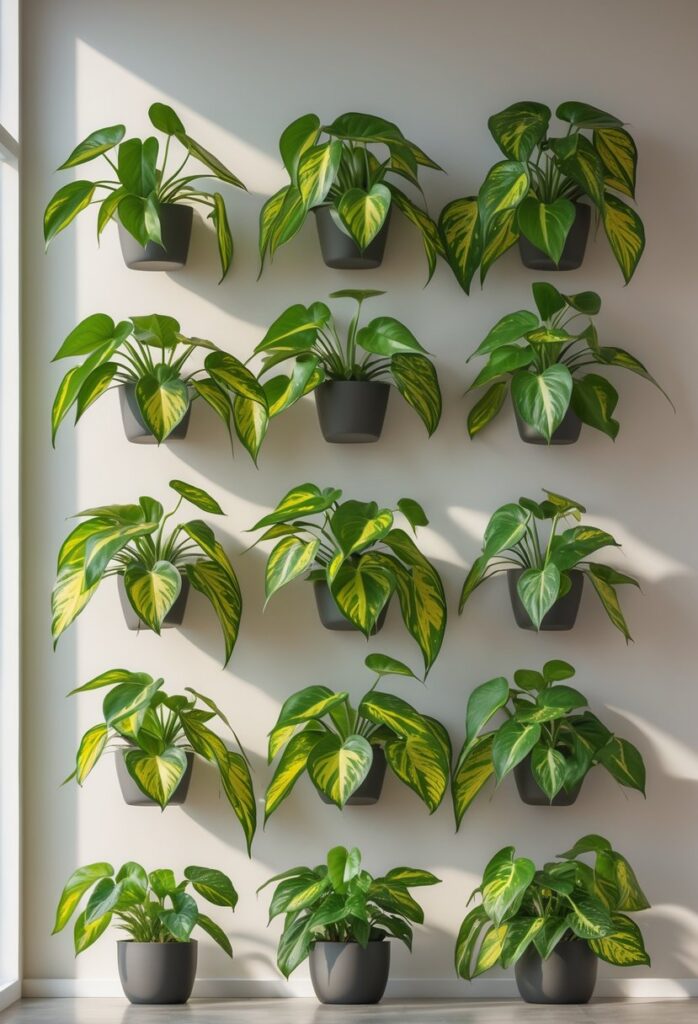
Philodendron Brasil is a popular indoor plant known for its bright green and yellow heart-shaped leaves. It is a vining plant that can trail or climb, making it versatile for walls or plant stands.
This plant grows best in bright, indirect light but can also survive in medium to low light conditions. It prefers moderate watering, allowing the top soil to dry out between waterings.
Philodendron Brasil is low maintenance and adapts well to different indoor environments. It can climb surfaces but may damage walls, so using a moss pole or trellis is recommended for support.
It grows quickly, so regular pruning helps maintain its shape. Propagation is easy by cuttings, which can root in water or soil. Overall, it adds a splash of color and texture with minimal care.
Learn more about this striking houseplant and its care at Philodendron Brasil care guide.
4) Spider Plant (Chlorophytum comosum)
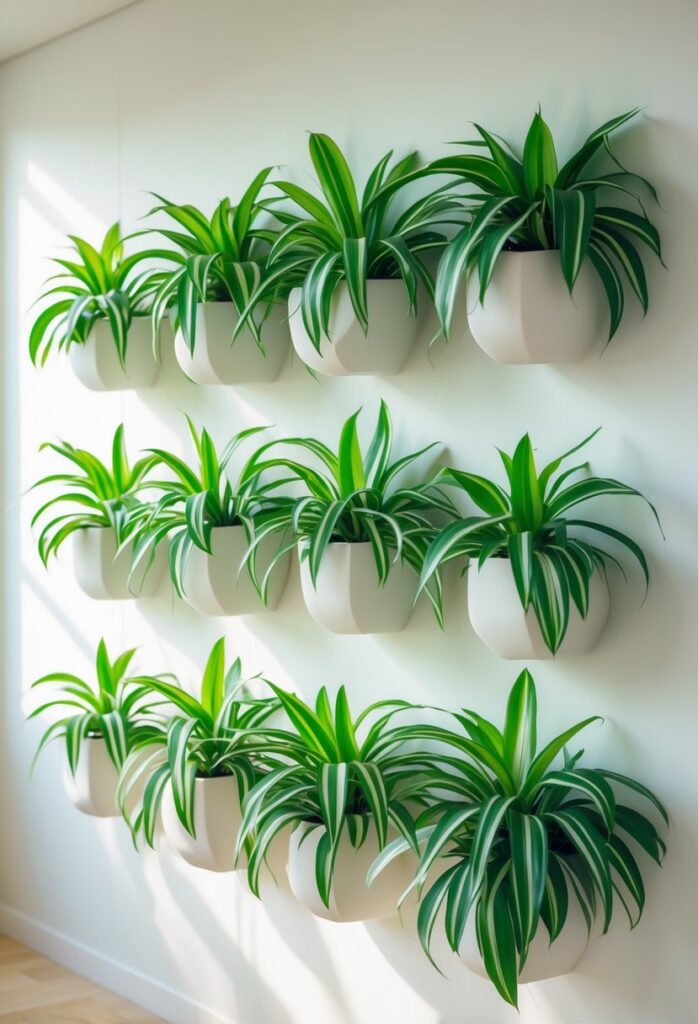
The spider plant is a popular choice for wall and hanging displays because of its long, arching leaves. It grows quickly and produces small plantlets, or “pups,” that can easily be propagated.
It thrives in bright, indirect light but can tolerate lower light levels. The spider plant prefers well-draining soil and should be watered when the top inch of soil feels dry.
This plant is known for improving indoor air quality by filtering out toxins. It is low-maintenance and adapts well to most indoor environments, making it suitable for both beginners and experienced gardeners.
Spider plants are also versatile in style. They add a fresh, green touch and work well in modern or traditional spaces. Their flowing foliage looks attractive when hung on a wall or placed on high shelves.
For more care tips and details, see the full Spider Plant Care and Growing Guide.
5) Calathea Orbifolia
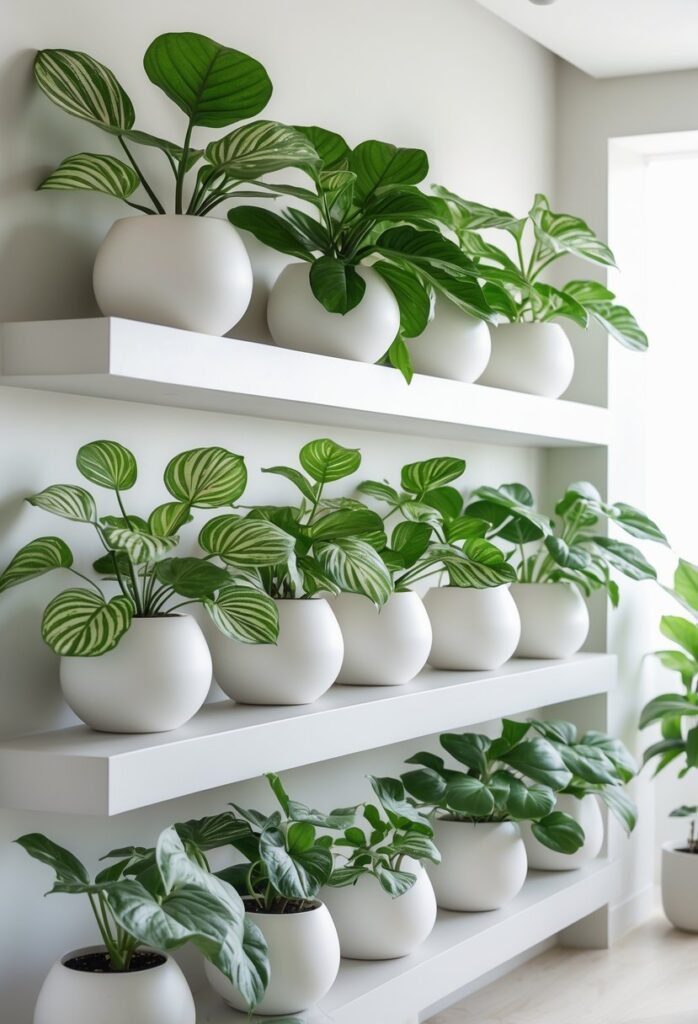
Calathea Orbifolia is known for its large, round leaves with striking silver-green stripes. It adds a bold, tropical look to any wall display. The plant is native to Bolivia and is popular as an indoor decorative plant because of its unique leaf patterns.
It prefers indirect, bright light but cannot tolerate direct sunlight, which can burn its leaves. The plant thrives in high humidity and needs consistently moist soil. Overwatering or letting the soil dry out can harm it.
Calathea Orbifolia has a natural “prayer” movement where its leaves fold up at night. This makes it an interesting and dynamic wall plant. It requires good airflow and occasional misting to avoid pests and leaf damage.
This plant can be a bit high-maintenance compared to others. However, with proper care, it stays lush and healthy. For more detailed care tips on Calathea Orbifolia, see this Calathea Orbifolia care guide.
6) Fiddle Leaf Fig (Ficus lyrata)
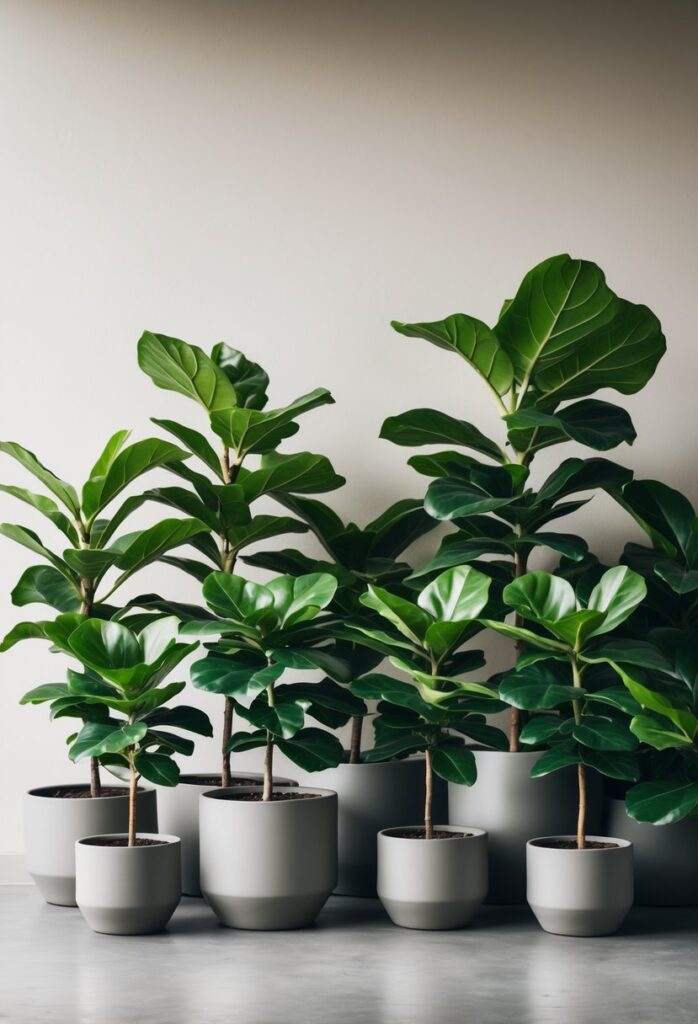
The Fiddle Leaf Fig is a popular indoor plant known for its large, glossy, violin-shaped leaves. It grows well indoors and can reach impressive heights, adding a strong visual impact to any room.
This plant prefers bright, filtered light but can tolerate some less ideal conditions. It needs regular watering, but the soil should dry out slightly between waterings to avoid root rot.
Fiddle Leaf Figs come from the tropical rainforests of West Africa. They can live many years with proper care, making them a long-term choice for indoor plant lovers.
Its bold leaves and tall shape make it a favorite for those who want a stylish and sculptural plant. It may seem finicky at times, but with steady care, it thrives well indoors.
For more detailed care tips, see this Fiddle Leaf Fig Care Guide.
7) String of Pearls (Senecio rowleyanus)
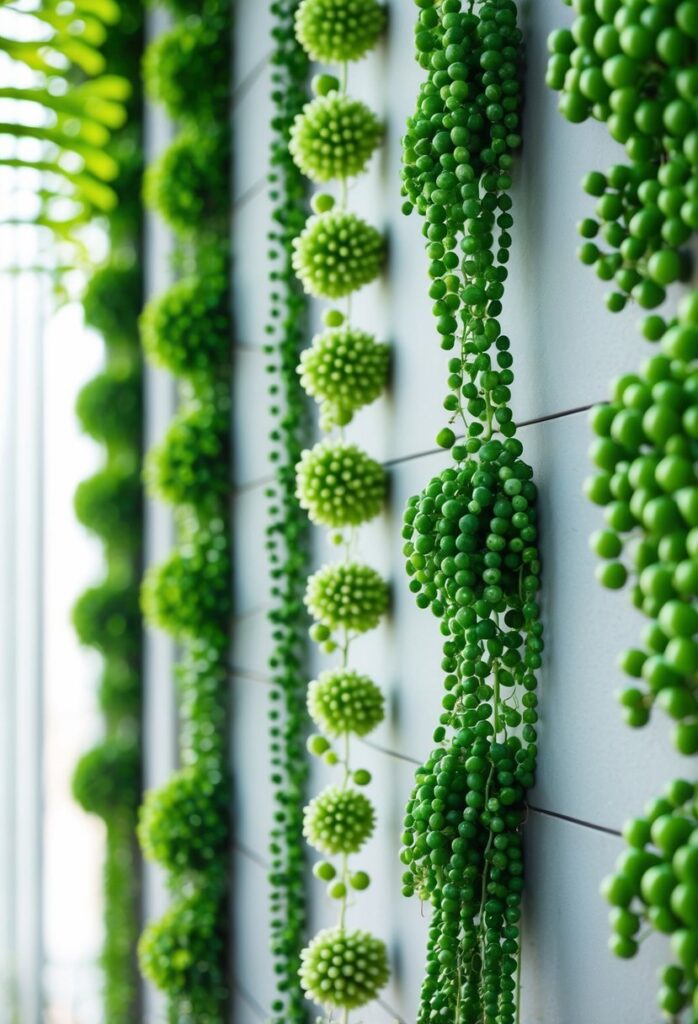
String of Pearls is a unique succulent known for its trailing stems covered with small, round leaves that look like green beads. It is a popular choice for wall displays because of its attractive, cascading vines.
This plant prefers bright, indirect light but can tolerate some direct sun. It thrives in well-draining soil and needs watering only when the top inch of soil feels dry. Overwatering can cause root rot, so it is best to keep water minimal.
String of Pearls is native to dry regions of South Africa. It stores water in its leaves, making it drought-tolerant and low maintenance. This quality suits people who want a houseplant with simple care needs.
It can be grown in hanging pots or mounted on wall frames to allow its vines to hang freely. It also easily propagates from cuttings, which makes growing new plants straightforward.
For more detailed information on care, visit the String of Pearls plant care and growing guide.
8) Boston Fern (Nephrolepis exaltata)
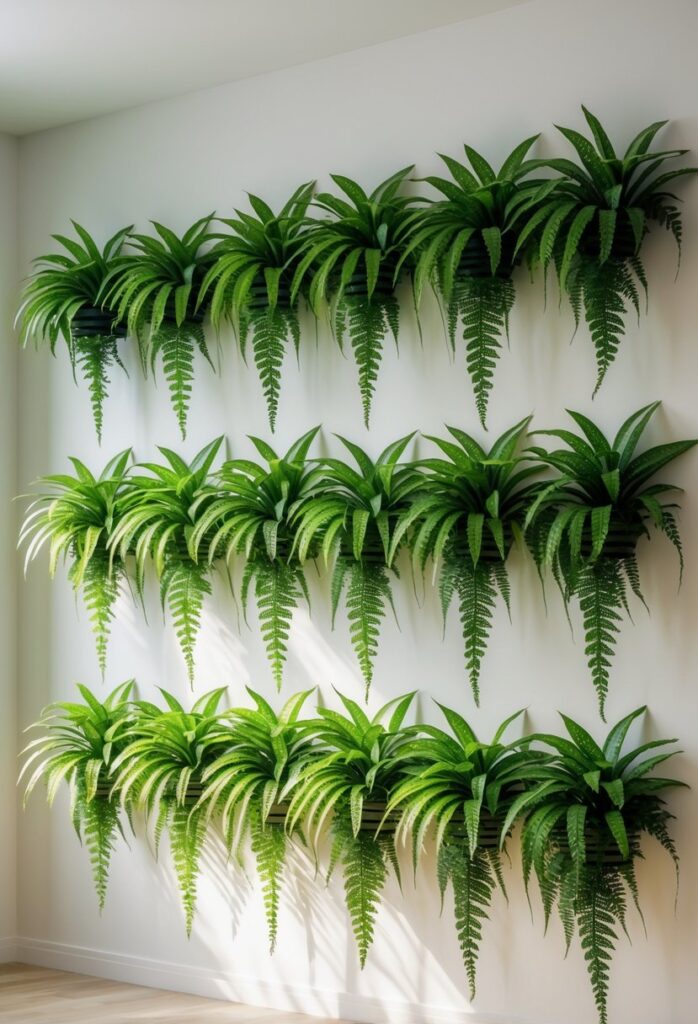
The Boston Fern is known for its lush, arching green fronds that add a soft, natural touch to any wall space. It thrives in bright, indirect light and prefers humidity levels between 60-70%. This makes it a good choice for indoor walls with filtered light and moist air.
It grows best in fertile, well-drained soil that stays consistently moist but not waterlogged. Regular misting or a nearby humidifier can help maintain the humidity it needs.
Boston Ferns do well in hanging baskets or vertical pots attached to walls. Their long, drooping fronds create a graceful look that works well in living rooms, bathrooms, or shaded patios.
Because it comes from tropical regions like Central and South America, the Boston Fern needs warmth between 15-25°C (59-77°F). It can struggle with direct sunlight or very dry air.
This plant can also help improve indoor air quality by removing pollutants. Its care does require attention to watering and humidity, but many find it rewarding for its classic green beauty. You can learn more about growing and caring for Boston Ferns from comprehensive guides like this one on Boston Fern care.
9) English Ivy (Hedera helix)

English Ivy is a strong and fast-growing vine that works well on walls and fences. It has dark green, lobed leaves that add a classic look to outdoor or indoor spaces. It can grow in bright indirect light and tolerates some shade.
This plant needs well-drained soil and regular watering, but it should not be waterlogged. Feeding it once a month during the growing season helps keep it healthy. English Ivy can climb walls by attaching with small rootlets.
While it helps cool buildings in summer, its vines can damage surfaces and leave marks when removed. It is also known to spread quickly and can become invasive if not managed properly.
English Ivy fits well for vertical green walls or ground cover where space is limited. Controlling its growth with regular pruning is important to prevent overgrowth. More detailed tips on growing and managing this plant can be found at English Ivy plant care guides.
10) ZZ Plant (Zamioculcas zamiifolia)
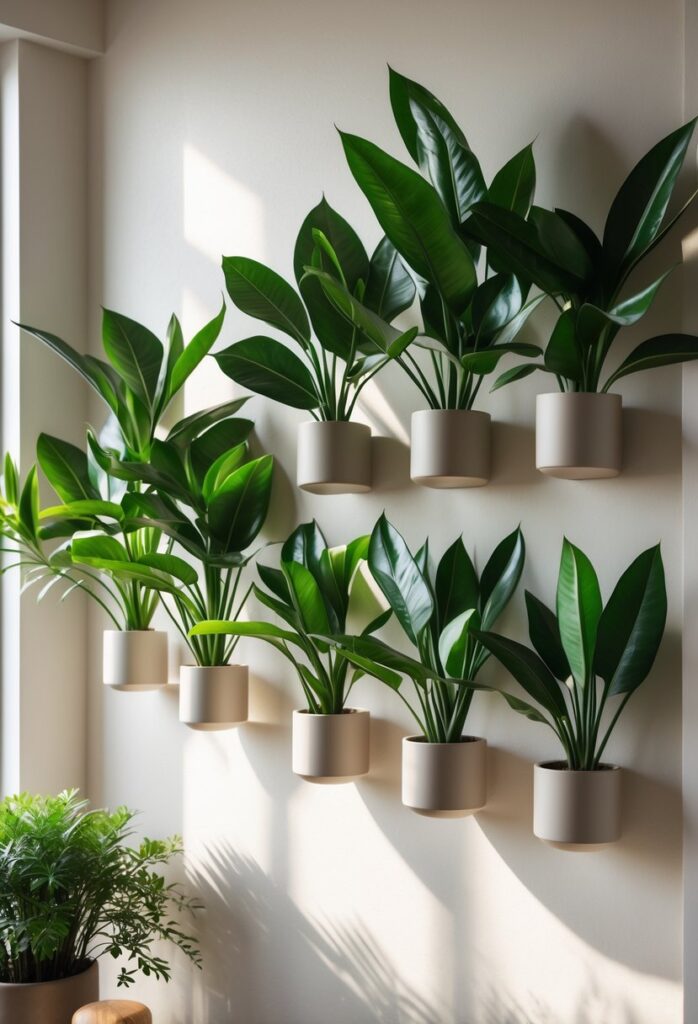
The ZZ Plant is a popular choice for indoor wall gardens because of its low maintenance needs. It has glossy, waxy leaves that add a sleek, green look to any space. It can grow up to 2-3 feet tall indoors, making it a striking feature on a vertical plant display.
This plant tolerates low light well, which makes it ideal for walls inside offices or homes where sunlight is limited. It prefers moderate watering, allowing the soil to dry out between waterings to prevent root rot.
The ZZ Plant can handle temperatures down to 40°F (5°C) but should be kept away from cold drafts. It is known for its air-purifying qualities, which help improve indoor air quality.
Pests are rare but can be washed away with a spray of water or treated with a mix of neem oil and soap. Its tough nature means it can thrive with little attention and still look healthy and vibrant. For more detailed care information, the ZZ Plant care guide offers useful tips.
11) Bird’s Nest Fern (Asplenium nidus)
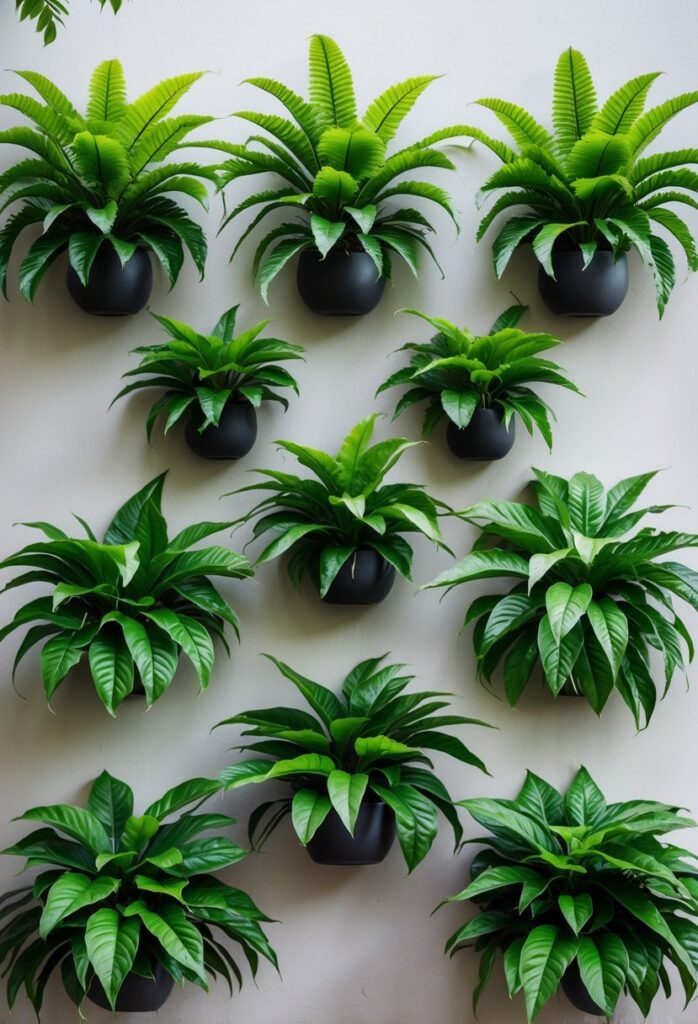
The Bird’s Nest Fern is an epiphytic fern known for its rosette of broad, bright green fronds. These fronds grow in a circular pattern that looks like a bird’s nest. It is popular as a houseplant because of its unique shape and lush greenery.
It thrives in warm, humid environments and prefers bright, indirect light. Direct sunlight can harm the leaves. This fern does well near north-facing windows where the light is gentle but steady.
The soil should stay consistently moist but not soggy. It grows best in well-draining, rich, all-purpose potting mix. Regular watering and feeding during the growing season help keep it healthy.
Bird’s Nest Ferns enjoy high humidity, so misting the leaves or using a humidifier can benefit the plant. It also likes stable temperatures and should be kept away from cold drafts.
This fern adds a tropical touch to indoor spaces while being relatively easy to care for. It grows steadily and can brighten rooms with its glossy, vibrant leaves. More guidance on care can be found at a detailed Bird’s Nest Fern Care Guide.
12) Succulent Mix (Echeveria, Sedum)
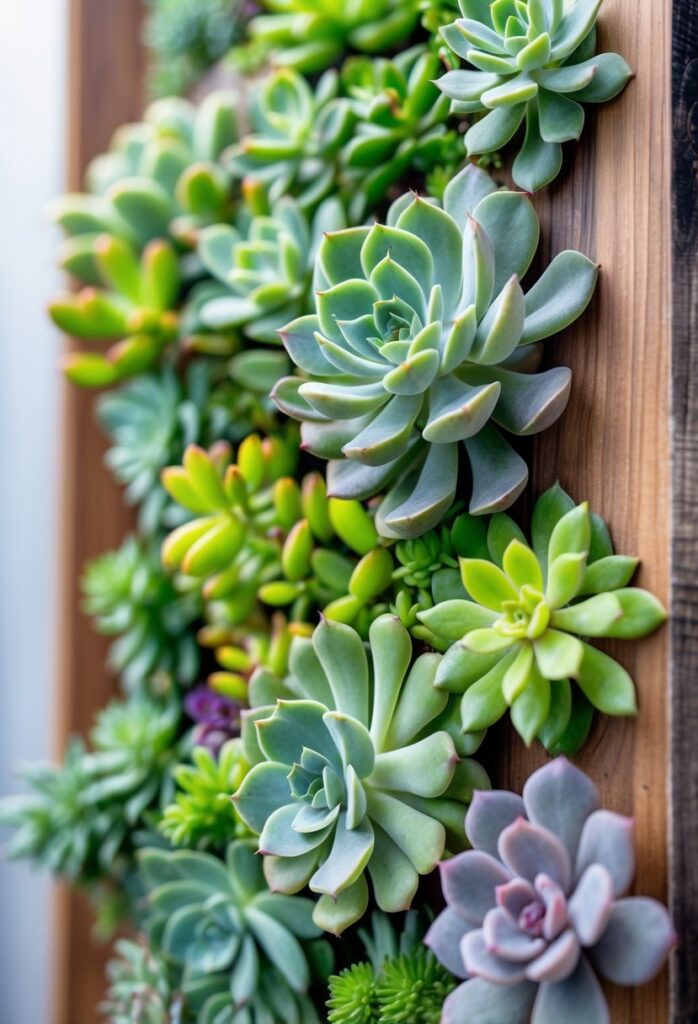
The mix of Echeveria and Sedum is popular for wall plants because both have similar care needs. They thrive in well-draining soil and prefer bright, indirect light. This combination is ideal for creating a visually appealing display with a variety of shapes and colors.
Echeveria plants have rosette leaves that come in many colors, including green, blue, and pink. Sedum adds texture with its small, plump leaves and can grow in clusters. Together, they create a balanced and interesting mix for vertical gardens.
Both plants are drought-tolerant and need watering only when the soil is dry. They grow well in warm temperatures between 60-85°F. This mix is low-maintenance and fits well in both indoor and outdoor settings.
For design inspiration and care tips, see the options for Echeveria and Sedum mix and other combinations. This makes them a reliable choice for anyone starting a succulent wall or adding variety to an existing display.
13) Hoya Carnosa
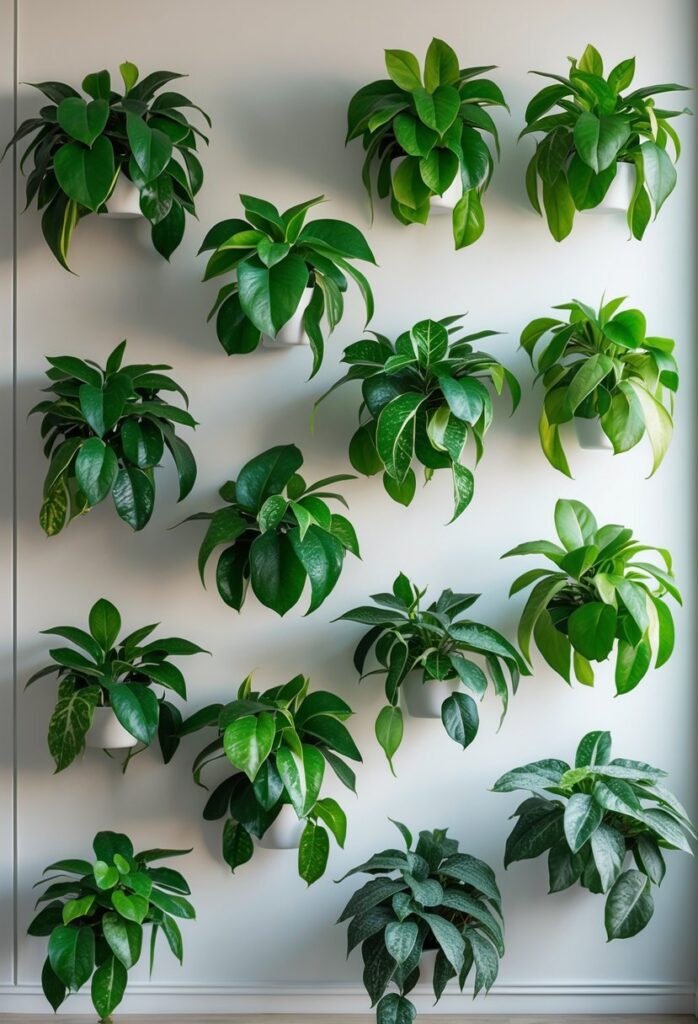
Hoya Carnosa is a popular wall plant known for its thick, waxy leaves and climbing vines. It is often used in hanging pots or trained to grow vertically along walls. The plant produces small, star-shaped flowers with a sweet fragrance.
It thrives in bright, indirect light but can tolerate some shade. Water should be given when the top inch of soil feels dry, making it a low-maintenance choice. Overwatering can cause root rot, so careful watering is important.
Hoya Carnosa is slow-growing but very hardy. It can live for many years with the right care. The plant is also easy to propagate from cuttings, allowing gardeners to expand their collection.
Its thick leaves help the plant retain moisture, which suits dry indoor environments. Flowering can be encouraged by giving it slightly less water during its rest period. More detailed care tips are available in the Hoya Carnosa care guide.
14) Maranta Leuconeura (Prayer Plant)
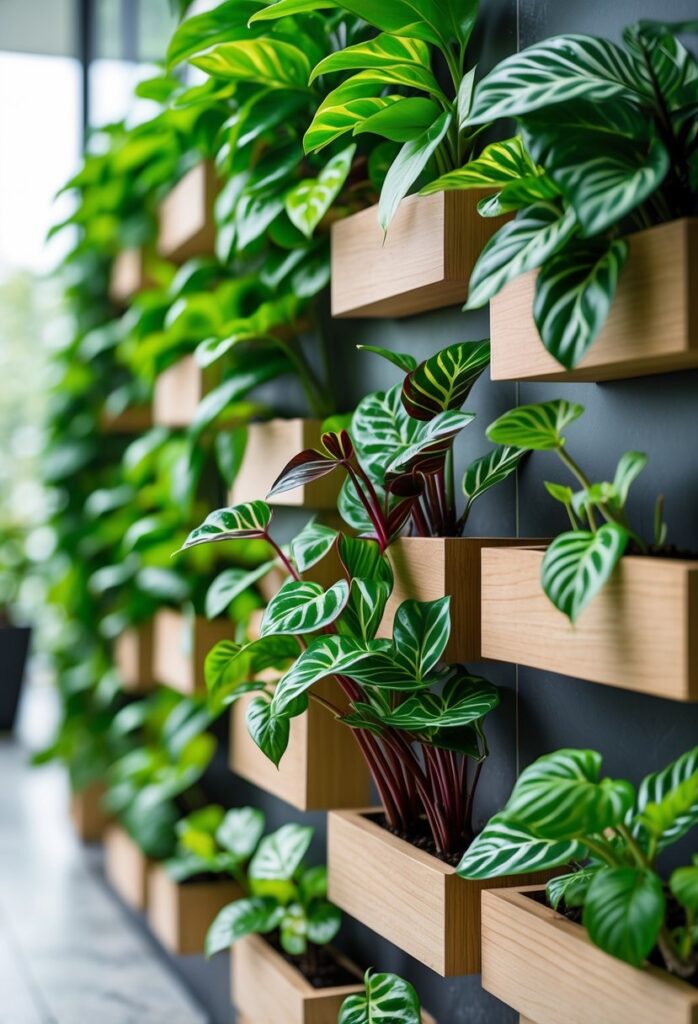
Maranta leuconeura, known as the Prayer Plant, is a popular indoor plant with striking green leaves and colorful veins. Its unique feature is the way its leaves fold up at night, resembling hands in prayer.
It thrives in bright, indirect light and prefers well-draining soil. The plant needs consistent moisture but should not be waterlogged. It is important to let the top layer of soil dry slightly between waterings.
This tropical plant enjoys high humidity and temperatures between 65 and 75°F. Feeding every two weeks during spring and summer helps maintain healthy growth.
The Prayer Plant adds color and interest to any wall garden through its patterned leaves and compact size. It responds well to typical indoor conditions when given proper care. More details on how to care for Maranta leuconeura can be found in this Prayer Plant care guide.
15) Peace Lily (Spathiphyllum)
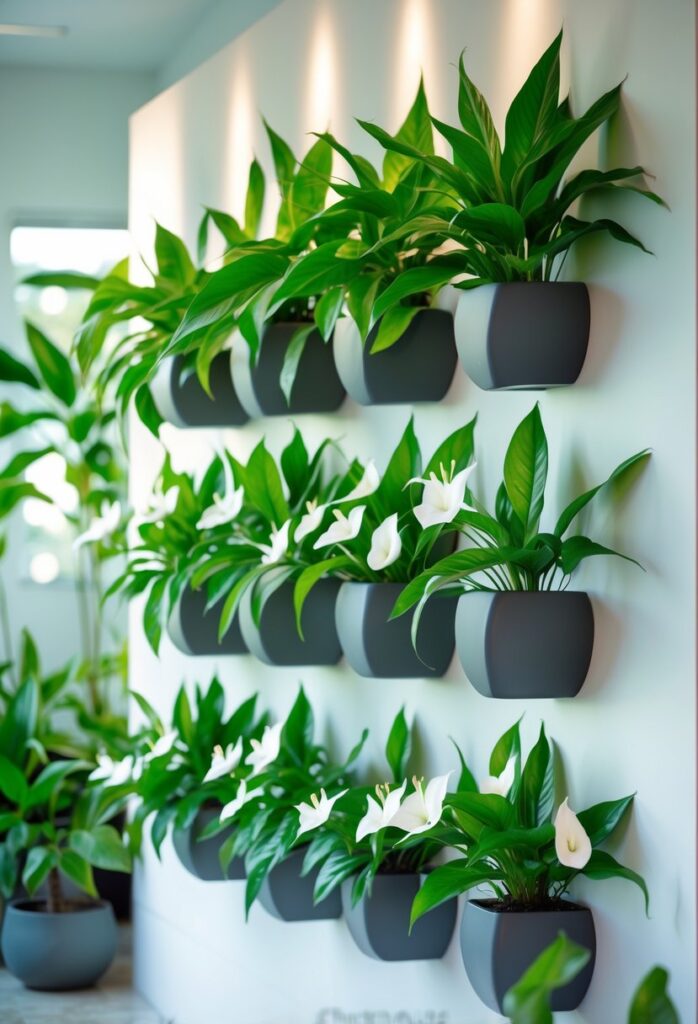
The Peace Lily is a popular indoor plant known for its dark green leaves and white, boat-shaped flowers. It thrives in low to medium light, making it ideal for indoor walls where sunlight is limited.
This plant prefers a warm and humid environment, similar to its native tropical rainforests. It needs regular watering but should not sit in water, as that can cause root rot.
The Peace Lily also helps improve indoor air quality by removing certain toxins. It requires minimal care but benefits from pruning spent blooms to keep it looking neat.
Its size and shape work well for hanging pots or wall-mounted planters. The Peace Lily adds a calm, natural touch to any indoor space while being easy to maintain.
For more details on growing and caring for this plant, visit the Peace Lily care guide on The Spruce.
16) Heartleaf Philodendron
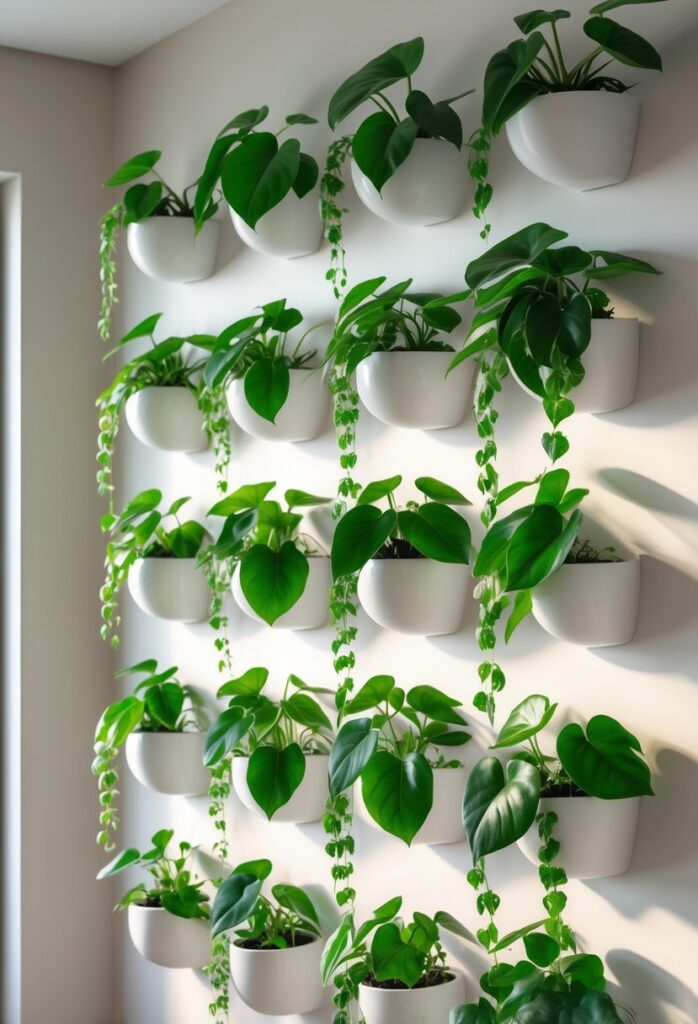
The Heartleaf Philodendron is a popular wall plant known for its shiny, heart-shaped leaves. It grows long vines that can trail down or climb up supports. This makes it ideal for decorating walls or hanging baskets.
It thrives in bright, indirect light but can also tolerate low light. The plant prefers well-draining soil and should be watered when the top feels dry. Overwatering can cause root problems.
This plant is native to tropical regions of Central and South America. It is sensitive to cold and needs temperatures above 60°F to stay healthy.
While easy to care for, the Heartleaf Philodendron is toxic to pets and children if ingested. Its lush green appearance adds a tropical feel to any indoor space.
More detailed care information is available in the Heartleaf Philodendron care guide.
Benefits of Wall Plants

Wall plants offer practical and attractive advantages that improve indoor environments. They can change air quality, make the most of small areas, and boost the look of any room or building.
Air Quality Improvement
Wall plants help clean the air by absorbing pollutants and releasing oxygen. They can reduce common indoor toxins like formaldehyde and benzene, which often come from furniture and cleaning products.
Some plants used on living walls, like spider plants and pothos, are known for their strong air-filtering abilities. These plants help lower dust levels and humidity, creating a fresher and healthier space.
With active growth in a vertical garden, air circulation can improve too, helping to reduce airborne germs. This benefit is especially useful in offices or homes where many people spend time.
Space Optimization
Wall plants make efficient use of vertical areas, turning empty walls into green zones. This allows for greenery without taking up valuable floor space, which is perfect for small rooms or urban apartments.
Vertical gardens can be installed indoors or outdoors on walls, fences, or balconies. Because they don’t require pots on the ground, they free up room for furniture or walking areas.
Many living walls use modular trays or panels to hold plants, making it easy to fit them in tight or unusual spaces. This approach suits gardening in places where traditional ground beds are not an option.
Enhanced Aesthetic Appeal
Wall plants create a living artwork that adds texture and color. They soften harsh architectural lines and provide a natural backdrop to interiors or building exteriors.
Using a mix of plant types—such as ferns, succulents, and flowering species—can add depth and variety to a wall. This variety makes a space feel more welcoming and alive.
Additionally, green walls can be designed to fit any style, from modern minimalism to lush tropical themes. The visual impact can transform bland walls into striking focal points that draw attention.
For more on designing living plant walls, refer to this guide on creating a living plant wall.
Caring for Your Wall Plants
Wall plants need precise care to stay healthy and vibrant. Proper watering, suitable light, and the right containers all affect their growth. Each factor plays a key role in maintaining strong roots and lush leaves.
Watering Techniques
Watering wall plants requires attention to their specific needs, as too much or too little can harm them. Most wall plants prefer consistent moisture but not soggy soil. Using a spray bottle or drip irrigation helps deliver water evenly across the vertical surface.
It’s best to check the soil moisture regularly by touching it. If the top inch feels dry, it’s time to water. Fast-draining soil and containers with drainage holes prevent water buildup, reducing root rot risk.
Water slowly to allow the moisture to reach deep roots. Plants like Pothos and Dracaena thrive with moderate watering every 1-2 weeks, but this varies by species and environment.
Light Requirements
Wall plants generally need indirect or filtered light rather than direct sunlight, which can scorch leaves. South or west-facing walls can work if sunlight is bright but diffused by curtains or nearby structures.
Low-light tolerant plants such as Snake Plant or ZZ Plant are good choices for dimmer indoor walls. Most wall plants prefer 6-8 hours of indirect light daily.
Artificial grow lights are helpful in spaces without natural light. Position lights 12-18 inches away and run them for 10-12 hours daily to mimic sunlight. Matching light to plant species supports photosynthesis and healthy growth.
Choosing the Right Planters
Planters must support the weight of the plants and allow proper drainage. Lightweight containers made from materials like plastic or resin reduce strain on wall mounts.
Planters should have built-in drainage holes to avoid water buildup. Modular planter systems designed for vertical gardens simplify installation and maintenance.
Consider the planter’s depth: shallow containers suit small plants with compact roots, while deeper ones are best for larger species like Anthurium.
Mount planters securely to the wall using brackets or frames designed to hold the combined weight of soil, plants, and water. Proper planter choice helps create a stable, thriving living wall.
Learn more about best plants for living walls from this guide to wall plants for indoor spaces.
Frequently Asked Questions
Choosing the right plants for a vertical garden depends on light, space, and humidity. Proper care includes regular watering and feeding tailored to each plant’s needs. Maximizing the wall’s visual appeal involves thoughtful arrangement and balancing plant growth habits.
How do I choose the best plants for a vertical garden wall?
Selecting plants like Snake Plant and Pothos works well because they tolerate low light and require less water. Consider a mix of species such as Philodendron Brasil and Calathea Orbifolia for variety in leaf shape and color. Also, make sure the plants can thrive in the space’s humidity and temperature.
What are the essential care tips for maintaining healthy wall-mounted plants?
Plants need consistent watering, but overwatering can cause root rot. Ensure proper drainage and check the soil moisture before watering. Regular pruning helps control growth and removes dead leaves to keep plants healthy.
Can indoor wall plants improve air quality, and if so, which species are most effective?
Yes, indoor plants like Snake Plant and Spider Plant can improve air quality by filtering toxins. These plants absorb carbon dioxide and release oxygen, contributing to better indoor air.
What are the top considerations for watering and fertilizing plants in a living wall setup?
Watering frequency depends on plant type and environmental conditions. Use drip irrigation or self-watering systems to evenly distribute water. Fertilize monthly during the growing season with a balanced, diluted fertilizer to support steady growth.
How can I design a wall plant arrangement for the most visual impact in a small space?
Use plants with contrasting leaf shapes and colors, like pairing Pothos with Calathea Orbifolia. Place larger plants at the bottom and trailing types higher up to create depth. Keep spacing even to allow airflow and prevent overcrowding.
What are the most common challenges when installing a plant wall and how can they be overcome?
Common issues include poor irrigation, insufficient light, and pest problems. Waterproof the wall properly to avoid damage. Use grow lights if natural light is low, and inspect plants regularly to catch pests early. Proper planning helps avoid most problems.
For more detailed care and installation tips, see Living Wall Solutions to Common Problems.
